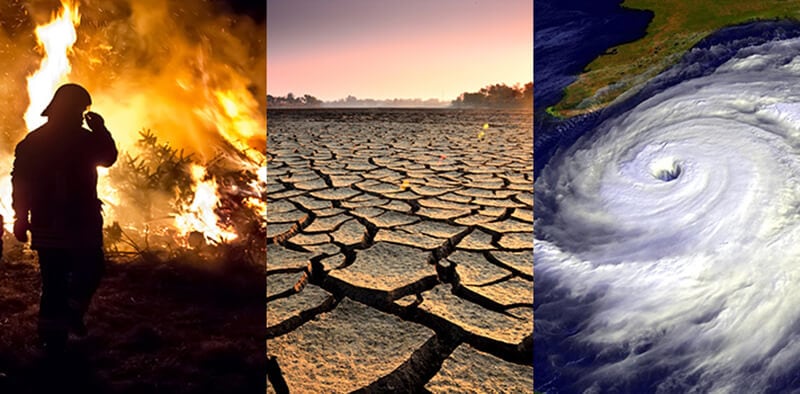- The climate change problem is urgent
- Daan Roosegaarde uses art and creativity to make a difference
- Roosegaarde’s vision for Beijing: a fleet of smog-eating bicycles
- Klaus Lackner and Allen Wright have science on their side: artificial trees
- Is this smog-eating tech viable?
The scientific consensus is clear: the planet is in trouble. Unchecked carbon emissions are causing the world’s temperature to climb, triggering extreme weather and rising sea levels. And we’re rapidly approaching the 1.5 degree Celsius limit proposed by the Paris Agreement on Climate Change. According to NASA, sea levels are now rising at a rate of 3.4 mm per year, and we’ve already seen global temperatures jump nearly a degree. These may seem like small changes, but on the level of our climate and the oceans, they’re huge – and we’re already feeling the effects!
The climate change problem is urgent
Scientists from Britain’s Chatham House, a think tank devoted to international affairs, argue that we’ve already passed the point where reductions can save us. Bill Hare, a scientist at Climate Analytics, a policy institute, agrees. “It’s something you don’t want to talk about very much but it’s an unaccountable truth: we will need geoengineering by the mid-2030s to have a chance at the [1.5-C] goal.” He’s been studying the effects of current and future warming, and the news isn’t good. “If you’re really concerned about coral reefs, biodiversity and food production in very poor regions, we’re going to have to deploy negative emission technology at scale,” Hare warned.
What Hare means by ‘negative emission technology at scale’ are innovative new approaches to strip carbon from the air. It’s not enough anymore to cut carbon emissions by reducing our dependence on fossil fuels – we’re at the point where we need to help nature undo the damage we’ve caused. This demands that we reimagine our approach to green tech, think outside the box, and embrace the weird and wonderful.

Daan Roosegaarde uses art and creativity to make a difference
No one knows this better than Daan Roosegaarde, a Dutch artist and designer. In 2016, he unveiled his Smog Free Tower in Rotterdam. Basically a scaled-up air purifier, it emits positively charged ions to cling to pollution, collecting these dirty particles with its negatively charged surface. While that sounds complex, if you’ve ever seen a tower-style indoor air purifier, you know exactly what it does. The 7-metre-tall structure can clean 30,000 cubic metres of air per hour, running on about as much electricity as an electric kettle. His vision is to place dozens – perhaps even hundreds – of these air cleaning towers in heavily polluted cities like Beijing, creating clean air ‘bubbles’ in parks and other public places. And he’s already installed one in the Chinese capital, where it’s working overtime to help people breathe.
Roosegaarde’s an artist – first and foremost – and his creativity is unmatched. Where someone else might merely dispose of the collected pollution, he sees beauty. The Smog Free Tower collects airborne pollutants in the form of gray-black soot. Anyone else would just throw this trash away, but Roosegaarde compresses these collected particles into tiny black cubes, encases them in acrylic, mounts them on a simple band, and voila – a Smog Free Ring is born!
Roosegaarde’s vision for Beijing: a fleet of smog-eating bicycles
But his creativity wasn’t exhausted with this idea. As Hare notes, scale is key. That got Roosegaarde thinking. And in China, where air pollution is chronic, nothing’s more common than the humble bicycle. In collaboration with ofo, a Chinese bike sharing programme, he wants to retrofit bikes with a system similar to that used in his Smog free Tower, essentially transforming the city’s bicycles into roving air purifiers. If adopted at scale in Beijing, where at least 2.4 million bicycles are offered for rent, and millions more are used as everyday transportation, the effect on air quality could be profound!
Klaus Lackner and Allen Wright have science on their side: artificial trees
Roosegaarde’s not alone, however. Klaus Lackner and Allen Wright, scientists at Arizona State university and directors of the Centre for Negative Carbon Emissions, realise that doing nothing isn’t an option. Working with engineers and other scientists, they’ve developed ‘artificial trees’ that scrub the air of carbon dioxide. Their invention isn’t beautiful – don’t image green leaves gently dancing in the wind – but it’s effective, nearly 1000 times better than the real thing. As Radhika Singh reports for The Borgen Project blog, “ten million artificial trees could absorb 3.6 billion tons of carbon dioxide a year. This would amount to 10% of all global emissions”. That’s huge!
Is smog-eating tech viable?
Unfortunately, the tech works best in warm, dry air and the trees cost about as much as a car to produce. Lackner and Wright say they need someone like Tesla’s Elon Musk to back their tech and help bring it to the market at an acceptable price. As Lackner told Fast Company, “you cannot drive down the price unless you actually do it […] I want to do it incrementally. Start small and be horribly inefficient. Admit it’s expensive and say, ‘This is our starting point.’”
Scientists caution, however, that although we need this new tech, we shouldn’t ignore or put off efforts to reduce emissions. Waleed Abdalati, a professor at the University of Colorado, Boulder, says that “the No. 1 outcome we wanted to make clear is there is no substitute for mitigation and adaptation”. And as Umair Irfan, a science reporter, explains for Scientific American, “carbon dioxide itself is not a very reactive molecule, so many proposals for sucking it up require an energy input. This means careful life-cycle accounting to make sure that more carbon dioxide comes out of the atmosphere in deploying these systems than goes in.”
It’s clear, then, that innovators like Roosegaarde and Lackner have their work cut out for them. Let’s hope they keep imagining bluer skies and greener cities!
Share via:


